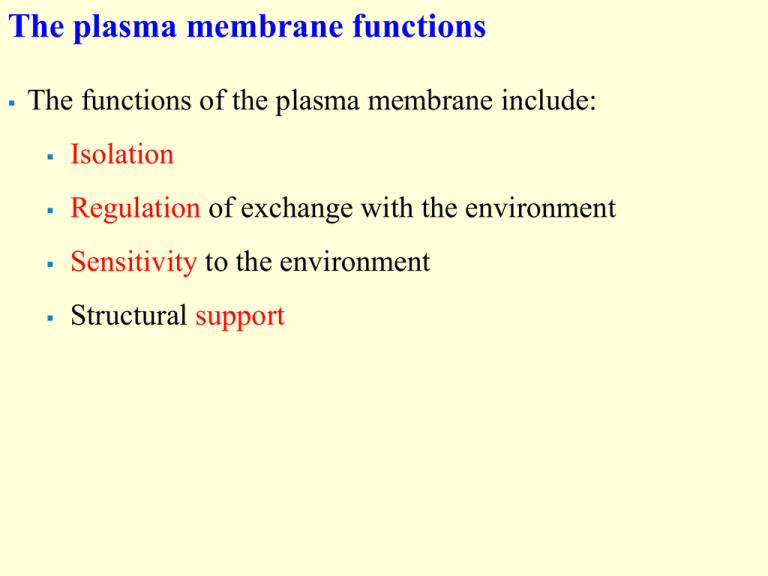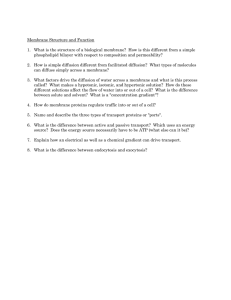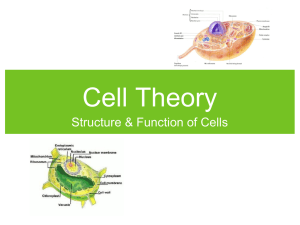The plasma membrane functions
advertisement

The plasma membrane functions The functions of the plasma membrane include: Isolation Regulation of exchange with the environment Sensitivity to the environment Structural support Plasma Membrane Physical barrier extracellular fluids Helps in maintaining homeostasis separates intracellular fluids from Plays a dynamic role in cellular activity – selectively permeable Fluid Mosaic Model Double bilayer phospholipids of Phospholipids have hydrophobic tails and hydrophilic heads Hydrophilic head Hydrophobic tails + CH3 CH2 N CH C3 H CH2 Phosphate 3 O group O P O – OC C C H H H 2 O2 O O O C C CH2 CH2 CH2 CH2 CH2 CH2 CH2 CH2 CH2 CH2 CH2 CH2 CH2 CH2 CH2 CH2 CH CH CH2 CH2 CH2 CH2 CH2 CH2 CH2 CH3 CH2 CH2 CH2 CH2 CH2 CH2 CH2 CH3 The plasma membrane includes proteins Integral proteins Within the membrane Peripheral proteins Bound to inner or outer surface of the membrane The plasma membrane includes proteins Anchoring proteins (stabilizers) Recognition proteins (identifiers) Bind and respond to ligands (ions, hormones) Carrier proteins Catalyze reactions Receptor proteins Label cells as normal or abnormal Enzymes Attach to inside or outside structures Transport specific solutes through membrane Channels Regulate water flow and solutes through membrane Structures on the plasma membrane surfaces Microvilli, Cilia, Stereocilia Specialized junctions Features of Apical Surface of Epithelium - Microvilli Projections that increase surface area Folding of the plasma membrane http://cellbio.utmb.edu/microanatomy/epithelia/epith_lec.htm Features of Apical Surface of Epithelium - Cilia These structures are designed for motility. Epithelia that need to move substances across their surface (like mucous in the air passages) have cilia. Each cilium or flagellum has a basal body located at its base. Basal bodies anchor the cilia or flagella and are thought to be responsible for their formation. They look like centrioles and are believed to be derived from them Flagella: (ex) spermatoza Extra long cilia Moves cell http://www.lbl.gov/Science-Articles/Archive/sabl/2006/Jul/02.html Cell junctions – 3 groups Tight junction Gap junction designed to restrict the movement of material between the cells they link create cytoplasmatic communication bridges between cells Anchoring junction attach cells to one another or to extracellular matrix Membrane Junctions Tight junction Gap junction http://www.phschool.com/science/biology_place/biocoach/biomembrane2/junctions.html Anchoring junction Tight Junctions An intercellular junction between cells in which the outer layers of the cell membranes fuse, reducing the ability of larger molecules and water to pass between the cells. Tight junctions prevent the free movement of molecules between cells in the intestine and allow the intestinal cell to control absorption Gap junctions Example – intercalated discs in the heart, electrical synapses Cell transport mechanisms How things enter and leave the cell 2 groups of movement Passive transport – no energy is needed Diffusion Carrier-mediated Active transport – requires ATTP Pumps Vesicular transport Characteristics of selectively permeable membranes EXTRACELLULAR FLUID Plasma membrane Passive mechanisms do not require ATP. Diffusion is movement driven by concentration differences. CYTOPLASM Materials may cross the plasma membrane through active or passive mechanisms. Active mechanisms require ATP. Carrier-mediated transport involves carrier proteins, and the movement may be passive or active. Vesicular transport involves the formation of intracellular vesicles; this is an active process. Passive transport All molecules in the body are in constant motion regardless of the presence of a membrane (kinetic energy) Motion stops only at absolute zero By international agreement, it is defined as 0K on the Kelvin scale, −273.15°C on the Celsius scale and −459.67°F on the Fahrenheit scale When a membrane is present the movement in a certain direction can be limited or changed A molecule will move in a certain direction until collide with another molecule. When this happens, the direction of the movement will change Diffusion Diffusion is the tendency for molecules to spread out evenly into the available space The driving force is kinetic energy Slow in air and water but important over small distances Although each molecule moves randomly, diffusion of a population of molecules may exhibit a net movement in one direction Depends on a concentration gradient. (What is a concentration? A concentration gradient?) At dynamic equilibrium, as many molecules cross one way as cross in the other direction Factors Affecting Diffusion Distance (inversely related) Molecule size (inversely related) Temperature (directly related) Gradient size (directly related) Electrical forces Attraction of opposite charges (+,–) Repulsion of like charges (+,+ or –,–) Diffusion The movement of molecules will happen in ALL directions What is usually important is the net rate of diffusion in a certain direction The net movement will be from high to low concentration until equilibrium is reached At equilibrium, the net movement is equal in all directions When a membrane is present Membrane can be: Freely permeable (this does not apply to plasma membrane) – allows passage of all substances Selectively permeable – permits passage of some materials and prevents passage of others Impermeable – cells can be impermeable to specific substances, but no living cell has a completely impermeable membrane Permeability characteristics of membranes Freely permeable membranes Ions Protein Selectively permeable membranes Carbohydrates Ions Protein — Lipids Freely permeable membranes allow any substance to pass without difficulty. Carbohydrates Ions Protein — Water Impermeable membranes — Water Water Lipids Selectively permeable membranes, such as plasma membranes, permit the passage of some materials and prevent the passage of others. Carbohydrates Lipids Nothing can pass through impermeable membranes. Cells may be impermeable to specific substances, but no living cell has an impermeable membrane. Selectively permeable membranes Selective based on: 1. 2. Characteristics of material to pass Size Electrical charge Molecular shape Lipid solubility Characteristics of membrane What lipids and proteins present How components are arranged Diffusion through cell membrane Diffusion is divided into 2 types: 1. Simple diffusion – the movement of particles through the membrane with no assistance Nonpolar / lipid-soluble substances that diffuse directly through the lipid bilayer Gases readily diffuse through lipid bilayer. (Ex. movement of oxygen inside cells and CO2 outside) Diffusion of water and other lipid-insoluble molecules happens via protein channels The channels are highly selective as a result of the diameter, shape, charge and chemical bonds Diffusion of lipid-soluble materials Diffusion of lipid-insoluble materials Diffusion through cell membrane 2. facilitated diffusion - Assisted by carrier protein Materials are bound to specific proteins and move through water-filled protein channels (big polar molecules; ex. – glucose) The facilitated diffusion rate depends on the rate in which the carrier protein molecule can undergo changes that allow passage Carrier Proteins Are integral transmembrane proteins Show specificity for certain polar molecules Their number will influence the amount that can be transferred through the membrane Osmosis Osmosis is a simple diffusion of water. It occurs through a selectively permeable membrane Occurs when the concentration of a water is different on opposite sides of a membrane Membrane must be freely permeable to water, selectively permeable to solutes Osmosis – osmolality, osmolarity and osmotic pressure Osmolality (molecular weight) - One osmole is 1 gram molecular weight Osmolarity (concentration) - One osmole in one liter Osmotic pressure – defined by the concentration of solute particles in a solution Is defined by the number of particles, not their size or nature Each particle in a solution, regardless of its mass, exerts the same pressure against the membrane Effects of Solutions of Varying Tonicity Tonicity – description of how the solution affects a cell Isotonic – solutions with the same solute concentration as that of the cytosol Hypertonic – solutions having greater solute concentration than that of the cytosol Hypotonic – solutions having lesser solute concentration than that of the cytosol Passive Membrane Transport: Filtration The passage of water and solutes through a membrane by hydrostatic pressure Pressure gradient pushes solute-containing fluid from a higher-pressure area to a lower-pressure area Depending on the size of the membrane pores only solutes of a certain size may pass through it. Transport that uses ATP A movement that can be against concentration gradient Uses ATP to move solutes across a membrane Two types: Active transport - use of carrier proteins Vesicular transport Types of Active Transport 2 types according to the source of energy used for the transport Primary active transport The energy for the transport derived directly from a high energy molecule – ATP The hydrolysis of ATP causes phosphorylation of a transport protein that in turn changes its shape. That change “promotes” the passage of materials (ex. Sodium-potassium pump) Fig. 7-16-7 EXTRACELLULAR FLUID Na+ [Na+] high [K+] low Na+ Na+ Na+ Na+ Na+ Na+ Na+ CYTOPLASM 1 Na+ [Na+] low [K+] high P ADP 2 ATP P 3 P P 6 5 4 Types of Active Transport Secondary active transports – one ATP-powered pump can drive secondary transport of other solutes. The energy is derived from the energy stored in creating the concentration gradient This concentration difference was created by the primary active transport that used ATP Secondary transport, like the primary, depends on carrier proteins, but without the need of energy Fig. 7-19 – + H+ ATP – H+ + H+ Proton pump H+ – H+ + – H+ + H+ Diffusion of H+ Sucrose-H+ cotransporter H+ Sucrose – – + + Sucrose Active transport Symport system – two substances are moved across a membrane in the same direction Antiport system – two substances are moved across a membrane in opposite directions (Na/K) Vesicular Transport Transport of large particles and macromolecules across plasma membrane using vesicles and ATP Endocytosis – enables large particles and macromolecules to enter the cell. Few types: Receptor-mediated endocytosis – selective process that depends on the binding of extracellular material to a specific receptor This binding initiates the endocytosis Phagocytosis – “cell eating”; endocytosis of solid objects pseudopods engulf solids and bring them into the cell’s interior Happens in specialized cells Pinocytosis – “cell drinking”; endocytosis of liquids. This is not a selective process and does not involve receptor Vesicular Transport Exocytosis – moves substance from the cell interior to the extracellular space Transcytosis – moving substances into, across, and then out of a cell Vesicular trafficking – moving substances from one area in the cell to another Passive Membrane Transport – Review Process Energy Source Simple diffusion Kinetic energy Facilitated diffusion Kinetic energy Osmosis Kinetic energy Filtration Hydrostatic pressure Example Movement of O2 through membrane Movement of glucose into cells Movement of H2O in & out of cells Formation of kidney filtrate Active Membrane Transport – Review Process Energy Source Example Active transport of solutes ATP Movement of ions across membranes Exocytosis ATP Neurotransmitter secretion Endocytosis ATP White blood cell phagocytosis




